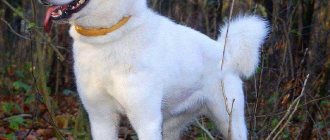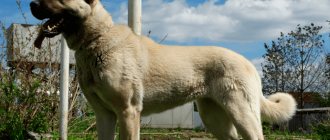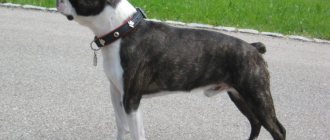In order to recognize and identify the symptoms of your beloved pet’s disease in time, you should pay attention to all external changes in time. Every change in behavior, lethargy, lack of appetite or obvious skin changes indicate the presence of certain diseases in the dog. Treating a dog at home is extremely dangerous. In case of certain symptoms, you should seek help from a veterinary specialist. Furunculosis is one of the most common diseases in dogs. What is he? How to recognize the symptoms of the disease in time?
Furunculosis is a disease that is bacterial in nature. Furunculosis is accompanied by purulent inflammation of the sebaceous gland and inflammation of the hair follicle in a dog. The main form of infection is considered to be pet contact and low dog immunity. Furunculosis is accompanied by the formation of boils in the dog’s body and is considered a fairly common disease.
A furuncle is a dense, cone-shaped swelling that is very painful for the animal. With the development and growth of the boil, it matures and reaches the size of a hazelnut. If a yellow-gray spot appears at the top of the boil, it means that the core of the boil has been formed. At the base of the shaft is hair. Opening of the boil can occur spontaneously. But, in such cases, the accumulated pus comes out and affects other areas of the skin, and new boils form.
Signs of an inflammatory process
With furunculosis in a dog, the following signs of the disease can be identified:
- A small knot around a dog's hair.
- Dense swelling, reddish in color.
- Painful sensations in the animal upon contact with the swelling.
- Over time, a yellow-gray spot appears at the site of the swelling.
- Spontaneous opening of the boil after some time.
General information
What is furunculosis?
Furunculosis is a disease of bacterial origin and is characterized by the appearance of ulcers of the sebaceous glands and inflammation of the dog’s hair follicle. Mostly, dogs with poor immunity become infected with furunculosis through contact with a sick person. Boils begin to appear on the dog’s body and bother him. This disease is quite common in dogs.
What is a boil?
The boil itself looks like a dense cone-shaped swelling. Dogs react very painfully to its appearance. Once the boil occurs, it begins to develop and grow, eventually maturing and reaching the size of a ruble coin. When a yellowish spot appears on the surface of the boil, its core is formed, at the base of which is a hair. At this stage of development, the boil may open on its own, which is extremely undesirable, because then the resulting pus will come to the surface of the skin, infection will occur and new boils will appear.
Causes of boils in dogs
The main cause of furunculosis is staphylococcus. In addition, reasons may include:
- — the dog’s state of stress (for example, moving or changing owner);
- - lack of vitamins in the body;
- - low hemoglobin, against which a loss of strength may occur;
- - dirty skin;
- - sores, abrasions on the dog’s skin;
- - indigestion.
Symptoms of furunculosis
During the disease with furunculosis, the following symptoms appear:
- - swelling, dense to the touch and externally reddish in color;
- - a small knot at the base of the dog's hair;
- - the dog displays aggression or pain when in contact with the sore;
- - over time, a yellowish spot appears on the sore;
- - After some time, the boil matures and opens on its own.
Stages and forms of the inflammatory process
The inflammatory process begins immediately after the staphylococcus bacteria enters the skin pore. The bacterium actively multiplies and causes inflammation in the skin tissues. The inflammatory process occurs in the following stages:
- Initial stage . The first stage is characterized by redness of the skin, increased body temperature of the dog, and swelling of the affected area.
- Progressive stage . Characterized by enlargement of the affected area of skin and painful sensations. If a boil forms on the paw, the dog will begin to limp; if there is a boil on the armpits or thighs, it will be difficult for her to sit and run.
- Acute stage . Increased body temperature, weakness of the animal and general malaise.
Furunculosis in dogs manifests itself in three forms. Each of which depends on the general condition of the pet and its predisposition. In the local form, a single inflammation forms. In this case, it is better to make an incision under anesthesia without waiting for the boil to mature. Several foci of the inflammatory process are observed in the localized form of furunculosis. To establish the causes, it is necessary to carry out diagnostics. The general form subsequently becomes chronic.
Inflamed boils appear on different parts of the animal's body. When the boil ripens, it is recommended to open it. You should not treat your dog on your own; it is important to seek help from a specialist.
Causes
The causative agent of the disease is Staphylococcus aureus or white, its activity and penetration under the skin are facilitated by various predisposing factors:
- Damage to the integrity of the skin: microtraumas, cuts, scratching due to skin diseases, bites, rubbing with a leash or muzzle;
- Skin and fur contamination;
- Seborrhea, acne;
- Metabolic and hormonal disorders;
- Hypovitaminosis;
- Chronic diseases;
- Anemia;
- Stress;
- Uncontrolled long-term antibiotic therapy;
- Genetic predisposition of dog breeds with folded skin.
Prevention and treatment of furunculosis
To avoid and maintain the general favorable condition of the dog, you should take care of a course of vitamins, proper nutrition and rest for the pet . On the area affected by the boil, cut off the skin and treat with an alcohol solution. At the first, initial stage, alcohol-containing dressings are used. This method allows you to interrupt the development of the boil.
At the stage of maturation and formation of the boil core, bandages with a solution of magnesium sulfate are used. After opening the boil, the wound is treated with a solution of brilliant green or zinc ointment of your choice. Let us highlight several main rules in the treatment of furunculosis:
- Maintaining proper nutrition.
- Compliance with hygienic standards for caring for the dog.
- Compresses made from ointments, which allow the process to accelerate and break the boil.
- Drugs with analgesic effect.
- Novocaine compresses.
- You can open a boil yourself only when it is fully mature, adhering to the basic rules of hygiene and care after opening.
In cases of infection, long-term antibiotic therapy is prescribed. Like other inflammatory processes, furunculosis manifests itself in several stages, and treatment is also carried out in different ways. The duration of treatment can take up to several months.
It is believed that furunculosis is inflamed by dirt. Take care of your dog. Wash your paws after walks and take care of your pet’s hygiene. It is important to adhere to recommendations for the use of vitamins and proper nutrition. The percentage of infection is minimized if all preventive recommendations are followed.
Abscess concept
An abscess in dogs is an inflammatory process that occurs in the skin, which is accompanied by the formation and accumulation of purulent formations due to necrosis (rotting) of tissue. A bag of pus, pieces of necrotic tissue and pathogenic microflora forms under the skin. Around the sac, the tissue becomes inflamed and the walls of an abscess begin to form, which consists of a surface layer formed by fibrous connective tissue and an internal, pyogenic layer of granulation tissue. If no measures are taken, the bag will grow and bother the animal. In addition to being painful, abscesses negatively affect the overall health of your pet.
The disease can be localized in any part of the body due to mechanical damage: bruises, injuries and injections. And if there are malfunctions in the functioning of the secretory organs, then an abscess of the gland may develop in the dog.
When the paraanal gland becomes inflamed, the excretory canal is blocked and the secretion accumulates inside. Finding no way out, the fluid overflows the gland, and the wall and skin rupture. This is an abscess that resembles an ulcer.
Complications and consequences of furunculosis
First of all, furunculosis is a very painful inflammatory complication. Furunculosis entails a number of complications and obvious threats to the life and health of the dog. It is important to determine the cause of inflammation. In this case, it will be much easier to cure furunculosis.
Boils can provoke inflammation of the animal's brain, sepsis or kidney problems. Due to such serious consequences, it is highly recommended not to allow furunculosis to occur, but to consult a veterinarian in time for further treatment.
Claws
Claws (nail, toenail, claw) are beak-shaped horny protrusions of the third phalanx of fingers.
Claws can be strong, weak, sharpened, or overgrown. The claws vary in color from light to black. Some standards only require dark claws.
Nails grow quite quickly and, if they are not naturally rubbed off on a hard surface or trimmed, they can affect the shape of the dog’s paw and movements. Sometimes long, curved nails can grow into the pads of the paws (especially on the 5th toes) and cause pain to the dog.
Dewclaws
The vestigial (dewclaw) finger is considered to be the first toe on the hind paw, although sometimes this term is also applied to the first toes on the forelimbs. The vestigial toe on the hind limbs is absent in most dogs. E. Wiesner and Z. Wheeler (1979) suggest that the formation of dewclaws in dogs represents an atavism, a return to the ancestral form - the kino-dictys, which lived in the Paleocene. They are not a sign of degeneration and do not affect the quality of the offspring in any way. The appearance of dewclaws is called polydactyly. The phenomenon of polydactyly is known only in domestic dogs; it has not been found in wolves and other wild canines. Thus, the presence of wolf-dog hybrids in nature is sometimes established.
The posterior vestigial finger often lacks the first or second phalanx and is attached only to the skin. Due to this weak attachment, it is prone to injury. The anterior vestigial finger usually has three phalanges and is firmly attached to the limb.
Dewclaws are usually removed at the request of the owner in small puppies, especially in breeds that require constant grooming (poodles, schnauzers, fox terriers), show dogs whose standard clearly states its absence, or hunting dogs to prevent injury. Sometimes, after a traumatic injury, the rudimentary finger is amputated in adult dogs.
However, in the standard for some breeds, dewclaws are indicated as a mandatory feature, including double toes (Great Pyrenees, Briard, Beauceron, Icelandic Cattle Dog).
In Pharaoh dogs and some other breeds, the appearance of additional fingers on the forelimbs, visually changed, was noted. They are usually located above the main toes and look like a wart. But, if you look closely, you can see that this new growth has villi, similar to the villi on the paw pads. Sometimes such a false finger has an underdeveloped claw. Additional fingers can have either completely all the constituent elements of the phalanx of the joint, or only part of these elements.
Polydactyly in the Pharaoh Hound
How to treat the disease
Treatment of the disease is carried out using different methods. The veterinarian should prescribe a course of general and local therapy or recommend surgery.
If a benign abscess is diagnosed in a dog, treatment is carried out with medication, which consists of:
- absorbable ointments used to treat unruptured formations;
- antiseptic solutions for treating wounds in spontaneous cases;
- antiseptic ointments that are applied to the wound channels.
The affected area should be washed with a syringe so as not to cause unnecessary inconvenience to the pet.
When a malignant abscess is diagnosed, surgery is prescribed to remove the purulent sac. Manipulation should be carried out as quickly as possible, before the disease spreads to adjacent tissues. In the postoperative period, general and local therapy and a course of antibiotics are carried out.
If the paraanal glands are affected, treatment should be carried out in a clinical setting. After examination and determination of the extent of the problem, drug treatment in combination with warm compresses will be prescribed. In more serious cases, the veterinarian will open and treat the abscess himself. Often, additional drainage is required to remove pus. Afterwards, treatment with strong antibiotics is prescribed to suppress pathogenic microflora, using rectal suppositories and local treatments.
Carbuncle in dogs
Carbuncle (Carbunculus).
This name refers to acute purulent inflammation of several nearby hair follicles, sebaceous glands with the loose connective tissue surrounding them. The disease is characterized by the development of a larger infiltrate than with a boil, followed by significant necrosis of the skin and subcutaneous tissue.
Etiology and pathogenesis
are the same as with a boil, but differ in the more extensive nature of their development. Due to necrosis of the skin and subcutaneous tissue, cavities and niches containing necrotic tissue are formed in the thickness of the carbuncle tissue. The demarcation barrier is poorly expressed, its formation is slow, so carbuncles can be the cause of the development of a general purulent infection (sepsis).
Clinical picture
characterized by a dense consistency, a very painful inflammatory infiltrate with the presence of several pustules. The infiltrate gradually increases, acquires a dense consistency and a purple color. A few days after the formation of the infiltrate, the skin becomes thinner and becomes necrotic in several places, followed by the release of purulent exudate. It takes on the appearance of being pierced by many holes filled with purulent-necrotic plugs. Subsequently, these holes merge, forming an ulcer. The disease is usually accompanied by purulent-resorptive fever with an increase in body temperature up to 40°C.
Treatment is the same as for phlegmon, complex with the use of local and general effects, as well as symptomatic and pathogenetic agents (see treatment of phlegmon in this article).
Brachydactyly
Brachydactyly is shortening of the outer toes of the front and sometimes hind paws. Caused by the absence or underdevelopment of the phalanges of the fingers. There are several types of brachydactyly in dogs:
- brachydactyly type A1 - a rudimentary structure of the middle phalanges is observed, in some cases there is a fusion of the phalanges with the terminal phalanges. Shortening of the proximal phalanges of the first toes and hands, growth retardation may occur;
- brachydactyly type A2 is marked by the presence of shortening of the middle phalanges of the second fingers of the hands, the remaining fingers are relatively preserved;
- brachydactyly type A3 – characterized by shortening and radial curvature of the middle fifth fingers of the hands;
- Brachydactyly type B is marked not only by a decrease in the length of the middle phalanges, but also by underdevelopment or complete absence of the terminal phalanges. Fusion of the second and third fingers is observed;
- Brachydactyly type C is characterized by shortening of the proximal and middle phalanges of the second and third fingers. Fusion of the phalanges and shortening of the metacarpal bones are observed;
- brachydactyly type D is diagnosed if there is shortening of the first fingers of the hands;
- brachydactyly type E – shortening of the metacarpal and metatarsal bones is observed.
Brachydactyly in the Mexican Hairless Dog
Diagnostic methods
Abscesses have much in common with hematomas, hernias and tumors, but the symptoms and contents of the formations are different. Therefore, in order to establish an accurate diagnosis and prescribe the correct treatment, the doctor conducts an examination and prescribes a number of examinations:
- the course of the disease is studied;
- the abscess is examined and palpated;
- a puncture is performed to study the contents;
- compare the temperature of the affected area and healthy tissue.
If necessary, an MRI or ultrasound may be prescribed. This is especially true for internal formations.
Symptoms
A lump appears at the site of the damage, which becomes larger before our eyes and bursts after a few days. These are signs of a superficial abscess. But with signs of deep things, everything is much more difficult. You can only notice that the dog is sick. She is depressed, has rapid breathing, fever, and is clearly experiencing pain in some specific place. And only in a veterinary clinic with an x-ray or a blood test (acute purulent inflammation will be visible in it) can a deep abscess be determined. Sometimes a chemical abscess can occur; this happens when substances that cause non-infectious inflammation are introduced into the tissues.
Eczema
Eczema is an inflammation of the superficial layer of the skin. It can be dry or weeping, focal (limited) or diffuse (scattered).
It begins with redness, the formation of compacted elevations (papules), turning into bubbles with liquid (vesicles). The vesicular exudate then becomes purulent and bursts, infecting the surrounding surface and causing maceration.
CAUSES:
- poor skin and coat care;
- use of unsuitable cleaning products;
- ectoparasites - lice, ticks, fleas;
- mechanical impact - rubbing the skin with a collar, muzzle, harness;
- chemicals - medicines, disinfectants.











